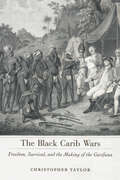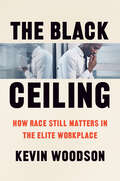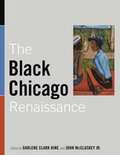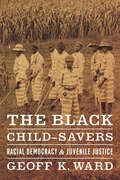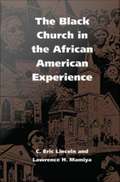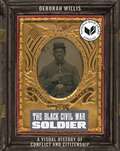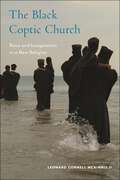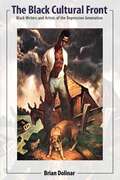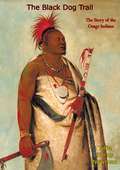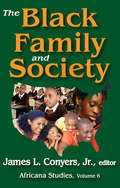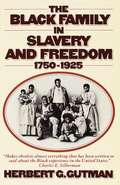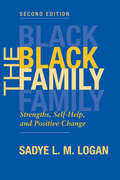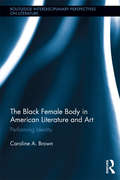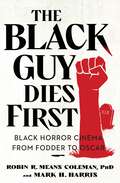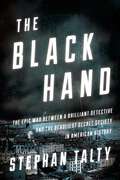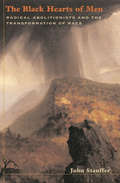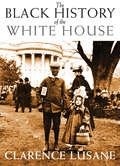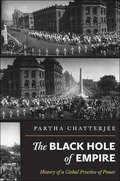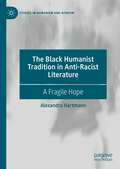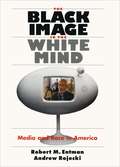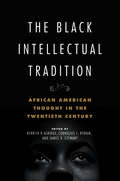- Table View
- List View
The Black Carib Wars: Freedom, Survival, and the Making of the Garifuna (Caribbean Studies Series)
by Christopher TaylorIn The Black Carib Wars, Christopher Taylor offers the most thoroughly researched history of the struggle of the Garifuna people to preserve their freedom on the island of St. Vincent. Today, thousands of Garifuna people live in Honduras, Belize, Guatemala, Nicaragua and the United States, preserving their unique culture and speaking a language that directly descends from that spoken in the Caribbean at the time of Columbus. All trace their origins back to St. Vincent where their ancestors were native Carib Indians and shipwrecked or runaway West African slaves—hence the name by which they were known to French and British colonialists: Black Caribs. In the 1600s they encountered Europeans as adversaries and allies. But from the early 1700s, white people, particularly the French, began to settle on St. Vincent. The treaty of Paris in 1763 handed the island to the British who wanted the Black Caribs' land to grow sugar. Conflict was inevitable, and in a series of bloody wars punctuated by uneasy peace the Black Caribs took on the might of the British Empire. Over decades leaders such as Tourouya, Bigot, and Chatoyer organized the resistance of a society which had no central authority but united against the external threat. Finally, abandoned by their French allies, they were defeated, and the survivors deported to Central America in 1797. The Black Carib Wars draws on extensive research in Britain, France, and St. Vincent to offer a compelling narrative of the formative years of the Garifuna people.
The Black Ceiling: How Race Still Matters in the Elite Workplace
by Kevin WoodsonA revelatory assessment of workplace inequality in high-status jobs that focuses on a new explanation for a pernicious problem: racial discomfort. America’s elite law firms, investment banks, and management consulting firms are known for grueling hours, low odds of promotion, and personnel practices that push out any employees who don’t advance. While most people who begin their careers in these institutions leave within several years, work there is especially difficult for Black professionals, who exit more quickly and receive far fewer promotions than their White counterparts, hitting a “Black ceiling.” Sociologist and law professor Kevin Woodson knows firsthand what life at a top law firm feels like as a Black man. Examining the experiences of more than one hundred Black professionals at prestigious firms, Woodson discovers that their biggest obstacle in the workplace isn’t explicit bias but racial discomfort, or the unease Black employees feel in workplaces that are steeped in Whiteness. He identifies two types of racial discomfort: social alienation, the isolation stemming from the cultural exclusion Black professionals experience in White spaces, and stigma anxiety, the trepidation they feel over the risk of discriminatory treatment. While racial discomfort is caused by America’s segregated social structures, it can exist even in the absence of racial discrimination, which highlights the inadequacy of the unconscious bias training now prevalent in corporate workplaces. Firms must do more than prevent discrimination, Woodson explains, outlining the steps that firms and Black professionals can take to ease racial discomfort. Offering a new perspective on a pressing social issue, The Black Ceiling is a vital resource for leaders at preeminent firms, Black professionals and students, managers within mostly White organizations, and anyone committed to cultivating diverse workplaces.
The Black Ceiling: How Race Still Matters in the Elite Workplace
by Kevin WoodsonA revelatory assessment of workplace inequality in high-status jobs that focuses on a new explanation for a pernicious problem: racial discomfort. America’s elite law firms, investment banks, and management consulting firms are known for grueling hours, low odds of promotion, and personnel practices that push out any employees who don’t advance. While most people who begin their careers in these institutions leave within several years, work there is especially difficult for Black professionals, who exit more quickly and receive far fewer promotions than their White counterparts, hitting a “Black ceiling.” Sociologist and law professor Kevin Woodson knows firsthand what life at a top law firm feels like as a Black man. Examining the experiences of more than one hundred Black professionals at prestigious firms, Woodson discovers that their biggest obstacle in the workplace isn’t explicit bias but racial discomfort, or the unease Black employees feel in workplaces that are steeped in Whiteness. He identifies two types of racial discomfort: social alienation, the isolation stemming from the cultural exclusion Black professionals experience in White spaces, and stigma anxiety, the trepidation they feel over the risk of discriminatory treatment. While racial discomfort is caused by America’s segregated social structures, it can exist even in the absence of racial discrimination, which highlights the inadequacy of the unconscious bias training now prevalent in corporate workplaces. Firms must do more than prevent discrimination, Woodson explains, outlining the steps that firms and Black professionals can take to ease racial discomfort. Offering a new perspective on a pressing social issue, The Black Ceiling is a vital resource for leaders at preeminent firms, Black professionals and students, managers within mostly White organizations, and anyone committed to cultivating diverse workplaces.
The Black Chicago Renaissance
by Darlene Clark Hine John MccluskeyBeginning in the 1930s, Black Chicago experienced a cultural renaissance that lasted into the 1950s and rivaled the cultural outpouring in the Harlem Renaissance of the 1920s. The contributors to this volume analyze this prolific period of African American creativity in music, performance art, social science scholarship, and visual and literary artistic expression. Unlike Harlem, Chicago was an urban industrial center that gave a unique working class and internationalist perspective to the cultural work being done in Chicago. This collection's various essays discuss the forces that distinguished the Black Chicago Renaissance from the Harlem Renaissance and placed the development of black culture in a national and international context. Among the topics discussed in this volume are Chicago writers Gwendolyn Brooks and Richard Wright, The Chicago Defender and Tivoli Theater, African American music and visual arts, and the American Negro Exposition of 1940. Contributors are Hilary Mac Austin, David T. Bailey, Murry N. DePillars, Samuel A. Floyd Jr., Erik S. Gellman, Jeffrey Helgeson, Darlene Clark Hine, John McCluskey Jr., Christopher Robert Reed, Elizabeth Schlabach, and Clovis E. Semmes.
The Black Child-Savers: Racial Democracy & Juvenile Justice
by Geoff K. WardDuring the Progressive Era, a rehabilitative agenda took hold of American juvenile justice, materializing as a citizen-and-state-building project and mirroring the unequal racial politics of American democracy itself. Alongside this liberal "manufactory of citizens,” a parallel structure was enacted: a Jim Crow juvenile justice system that endured across the nation for most of the twentieth century. In The Black Child Savers, the first study of the rise and fall of Jim Crow juvenile justice, Geoff Ward examines the origins and organization of this separate and unequal juvenile justice system. Ward explores how generations of “black child-savers” mobilized to challenge the threat to black youth and community interests and how this struggle grew aligned with a wider civil rights movement, eventually forcing the formal integration of American juvenile justice. Ward’s book reveals nearly a century of struggle to build a more democratic model of juvenile justice—an effort that succeeded in part, but ultimately failed to deliver black youth and community to liberal rehabilitative ideals. At once an inspiring story about the shifting boundaries of race, citizenship, and democracy in America and a crucial look at the nature of racial inequality, The Black Child Savers is a stirring account of the stakes and meaning of social justice.
The Black Child-Savers: Racial Democracy and Juvenile Justice
by Geoff K. WardDuring the Progressive Era, a rehabilitative agenda took hold of American juvenile justice, materializing as a citizen-and-state-building project and mirroring the unequal racial politics of American democracy itself. Alongside this liberal "manufactory of citizens," a parallel structure was enacted: a Jim Crow juvenile justice system that endured across the nation for most of the twentieth century. In The Black Child Savers, the first study of the rise and fall of Jim Crow juvenile justice, Geoff Ward examines the origins and organization of this separate and unequal juvenile justice system. Ward explores how generations of "black child-savers" mobilized to challenge the threat to black youth and community interests and how this struggle grew aligned with a wider civil rights movement, eventually forcing the formal integration of American juvenile justice. Ward's book reveals nearly a century of struggle to build a more democratic model of juvenile justice--an effort that succeeded in part, but ultimately failed to deliver black youth and community to liberal rehabilitative ideals. At once an inspiring story about the shifting boundaries of race, citizenship, and democracy in America and a crucial look at the nature of racial inequality, The Black Child Savers is a stirring account of the stakes and meaning of social justice.
The Black Church in the African American Experience
by C. Eric Lincoln Lawrence H. MamiyaBlack churches in America have long been recognized as the most independent, stable, and dominant institutions in black communities. In The Black Church in the African American Experience, based on a ten-year study, is the largest nongovernmental study of urban and rural churches ever undertaken and the first major field study on the subject since the 1930s. Drawing on interviews with more than 1,800 black clergy in both urban and rural settings, combined with a comprehensive historical overview of seven mainline black denominations, C. Eric Lincoln and Lawrence H. Mamiya present an analysis of the Black Church as it relates to the history of African Americans and to contemporary black culture. In examining both the internal structure of the Church and the reactions of the Church to external, societal changes, the authors provide important insights into the Church's relationship to politics, economics, women, youth, and music. Among other topics, Lincoln and Mamiya discuss the attitude of the clergy toward women pastors, the reaction of the Church to the civil rights movement, the attempts of the Church to involve young people, the impact of the black consciousness movement and Black Liberation Theology and clergy, and trends that will define the Black Church well into the next century. This study is complete with a comprehensive bibliography of literature on the black experience in religion. Funding for the ten-year survey was made possible by the Lilly Endowment and the Ford Foundation.
The Black Civil War Soldier: A Visual History of Conflict and Citizenship (NYU Series in Social and Cultural Analysis #11)
by Deborah WillisA stunning collection of stoic portraits and intimate ephemera from the lives of Black Civil War soldiersThough both the Union and Confederate armies excluded African American men from their initial calls to arms, many of the men who eventually served were black. Simultaneously, photography culture blossomed—marking the Civil War as the first conflict to be extensively documented through photographs. In The Black Civil War Soldier, Deb Willis explores the crucial role of photography in (re)telling and shaping African American narratives of the Civil War, pulling from a dynamic visual archive that has largely gone unacknowledged.With over seventy images, The Black Civil War Soldier contains a huge breadth of primary and archival materials, many of which are rarely reproduced. The photographs are supplemented with handwritten captions, letters, and other personal materials; Willis not only dives into the lives of black Union soldiers, but also includes stories of other African Americans involved with the struggle—from left-behind family members to female spies. Willis thus compiles a captivating memoir of photographs and words and examines them together to address themes of love and longing; responsibility and fear; commitment and patriotism; and—most predominantly—African American resilience.The Black Civil War Soldier offers a kaleidoscopic yet intimate portrait of the African American experience, from the beginning of the Civil War to 1900. Through her multimedia analysis, Willis acutely pinpoints the importance of African American communities in the development and prosecution of the war. The book shows how photography helped construct a national vision of blackness, war, and bondage, while unearthing the hidden histories of these black Civil War soldiers. In combating the erasure of this often overlooked history, Willis asks how these images might offer a more nuanced memory of African-American participation in the Civil War, and in doing so, points to individual and collective struggles for citizenship and remembrance.
The Black Coptic Church: Race and Imagination in a New Religion (Religion, Race, and Ethnicity)
by Leonard Cornell McKinnis IIProvides an illuminating look at the diverse world of Black religious life in North America, focusing particularly outside of mainstream Christian churchesFrom the Moorish Science Temple to the Peace Mission Movement of Father Divine to the Commandment Keepers sect of Black Judaism, myriad Black new religious movements developed during the time of the Great Migration. Many of these stood outside of Christianity, but some remained at least partially within the Christian fold. The Black Coptic Church is one of these. Black Coptics combined elements of Black Protestant and Black Hebrew traditions with Ethiopianism as a way of constructing a divine racial identity that embraced the idea of a royal Egyptian heritage for its African American followers, a heroic identity that was in stark contrast to the racial identity imposed on African Americans by the white dominant culture. This embrace of a royal Blackness—what McKinnis calls an act of “fugitive spirituality”—illuminates how the Black Coptic tradition in Chicago and beyond uniquely employs a religio-performative imagination. McKinnis asks, ‘What does it mean to imagine Blackness?’ Drawing on ten years of archival research and interviews with current members of the church, The Black Coptic Church offers a look at a group that insisted on its own understanding of its divine Blackness. In the process, it provides a more complex look at the diverse world of Black religious life in North America, particularly within non-mainstream Christian churches.
The Black Cultural Front: Black Writers and Artists of the Depression Generation (Margaret Walker Alexander Series in African American Studies)
by Brian DolinarThe Black Cultural Front describes how the social and political movements that grew out of the Depression facilitated the left turn of several African American artists and writers. The Communist-led John Reed Clubs brought together black and white writers in writing collectives. The Congress of Industrial Organizations's effort to recruit black workers inspired growing interest in the labor movement. One of the most concerted efforts was made by the National Negro Congress (NNC), a coalition of civil rights and labor organizations, which held cultural panels at its national conferences, fought segregation in the culture industries, promoted cultural education, and involved writers and artists in staging mass rallies during World War II.The formation of a black cultural front is examined by looking at the works of poet Langston Hughes, novelist Chester Himes, and cartoonist Ollie Harrington. While none of them were card-carrying members of the Communist Party, they all participated in the Left at one point in their careers. Interestingly, they all turned to creating popular culture in order to reach the black masses who were captivated by the movies, radio, newspapers, and detective novels. There are chapters on the Hughes' "Simple" stories, Himes' detective fiction, and Harrington's "Bootsie" cartoons.Collectively, the experience of these three figures contributes to the story of a "long" movement for African American freedom that flourished during the 1930s, 1940s, and 1950s. Yet this book also stresses the impact that McCarthyism had on dismantling the Black Left and how it affected each individual involved. Each was radicalized at a different moment and for different reasons. Each suffered for their past allegiances, whether fleeing to the haven of the "Black Bank" in Paris, or staying home and facing the House Un-American Activities Committee (HUAC). Yet the lasting influence of the Depression in their work was evident for the rest of their lives.
The Black Curator: Activists for Representation, and Decolonization of Museums (Museums in Focus)
by Kemuel BenyehudahThe Black Curator highlights the role that Black curators have long played in advocating for black artists and social changes and argues that they made a significant contribution to the democratization of museums over the last 150 years.Drawing on oral testimonies and archival research, this book examines how black curatorial activist practices emerged as a social and imaginative response to racism across various museum contexts. Exploring the work of black curators at three different museums, Benyehudah traces a lineage from black curators in the 19th century to those currently working in curatorial roles. Analysis of these case studies and the use of ideas from museum studies, critical race theory, and art history also enable the author to demonstrate how black curatorial practice was and is distinct from Eurocentric forms of curating black art. Explaining that the black curatorial lens was used in the process of establishing counter‑archives, the author also demonstrates that it has played – and continues to play – a vital role in the decolonization of museums.Offering compelling ways to look at the relationship between black curators and legacies of colonialism in museums, The Black Curator will be essential reading for scholars, students, and museum practitioners.
The Black Dog Trail: The Story of the Osage Indians
by Tillie Karns NewmanFascinating and detailed account of the Osage Indians spanning present day Kansas and Oklahoma, centring on the leadership of Black Dog the elder and his son also named Black Dog.“It was the first Chief Black Dog who conceived and engineered the Black Dog Trail for hunting and mourning parties. It was he who directed the building of a race track for young braves to develop speed in running and other athletics. And it was he who understood the significance of the Mottled Eagle (Hon-’ga) from which he descended.During his life time, he led the Osages courageously and unselfishly through disasters and trying events into worthwhile undertakings and happy surroundings.The second Chief Black Dog, upon the death of his father, fell heir to leadership and much trouble, in the beginning. However, he was resourceful with foresight and decision, and was able during the Civil War and the turn of the century to guide his people into greener pastures than those frequently noted by historians. He encountered many difficulties, temptations and disappointments; he left no male descendant to carry on the prized name of “Black Dog.”He lived until 1910, long enough to lend his influence with the Osage Nation towards making an oil and gas lease on a million and a half acres of their land, and by this counsel helped his people to become the wealthiest of all Indian tribes.”
The Black Family and Society: Africana Studies (Africana Studies)
by Jr. ConyersThis volume focuses on the black family in the United States and the social forces and issues that affect it, including education, healthcare, racism, poverty, and politics. It examines the effects of these social forces on individuals as well as families.Contributions are varied. "A Biscuit for a Letter" examines education in the antebellum South. "Black Intellectuals on Trial" and "Africans' Perspectives on Race in the US" both analyse the role of race and racism in America. "Feminization of Poverty and the Black Family" illustrates the double burden of race and gender borne by black women. "It's Gotta Be Some Drama!" analyses the televised depiction of black colleges and universities. "African-centred Research Frameworks" studies the importance of cultural awareness in academia. "Work to Be Done" recounts the activism of black women in the Democratic Party.This volume offers an interdisciplinary approach to study of the black family in the United States, taking into account the forces of the larger society that influence it. The Black Family and Society is the most recent volume in Transaction's Africana Studies series.
The Black Family in Slavery and Freedom, 1750-1925
by Herbert G. GutmanAn exhaustively researched history of black families in America from the days of slavery until just after the Civil War.
The Black Family: Strengths, Self-help, And Positive Change, Second Edition
by Sadye LoganWith numerous selections designed to reinforce the goal of empowering clients to take charge of their lives, this revised and updated second edition of The Black Family serves a two-fold purpose. It extends the small but growing body of strength-oriented literature to include African-American families and it serves as a natural extension of current texts on African-American families to provide social workers and the education community with a broader framework for understanding the needs of Black families. Offering both a research orientation and a practice perspective, this book should appeal to social work educators and practitioners involved in family services, health and mental health settings, and child and public welfare.
The Black Female Body in American Literature and Art: Performing Identity (Routledge Interdisciplinary Perspectives on Literature)
by Caroline BrownThis book examines how African-American writers and visual artists interweave icon and inscription in order to re-present the black female body, traditionally rendered alien and inarticulate within Western discursive and visual systems. Brown considers how the writings of Toni Morrison, Gayl Jones, Paule Marshall, Edwidge Danticat, Jamaica Kincaid, Andrea Lee, Gloria Naylor, and Martha Southgate are bound to such contemporary, postmodern visual artists as Lorna Simpson, Carrie Mae Weems, Kara Walker, Betye Saar, and Faith Ringgold. While the artists and authors rely on radically different media—photos, collage, video, and assembled objects, as opposed to words and rhythm—both sets of intellectual activists insist on the primacy of the black aesthetic. Both assert artistic agency and cultural continuity in the face of the oppression, social transformation, and cultural multiplicity of the late twentieth and early twenty-first centuries. This book examines how African-American performative practices mediate the tension between the ostensibly de-racialized body politic and the hyper-racialized black, female body, reimagining the cultural and political ground that guides various articulations of American national belonging. Brown shows how and why black women writers and artists matter as agents of change, how and why the form and content of their works must be recognized and reconsidered in the increasingly frenzied arena of cultural production and political debate.
The Black Guy Dies First: Black Horror Cinema from Fodder to Oscar
by Robin R. Means Coleman Mark H. HarrisA definitive and surprising exploration of the history of Black horror films, after the rising success of Get Out, Candyman, and Lovecraft Country from creators behind the acclaimed documentary, Horror Noire.The Black Guy Dies First explores the Black journey in modern horror cinema, from the fodder epitomized by Spider Baby to the Oscar-winning cinematic heights of Get Out and beyond. This eye-opening book delves into the themes, tropes, and traits that have come to characterize Black roles in horror since 1968, a year in which race made national headlines in iconic moments from the enactment of the 1968 Civil Rights Act and Martin Luther King Jr.&’s assassination in April. This timely book is a must-read for cinema and horror fans alike.
The Black Hand: The Epic War Between a Brilliant Detective and the Deadliest Secret Society in American History
by Stephan TaltySoon to be a major motion picture starring Leonardo DiCaprio, this gripping true story of the origins of the Mafia in America follows the brilliant Italian-born detective who gave his life to stop it. Beginning in the summer of 1903, an insidious crime wave filled New York City, and then the entire country, with fear. The children of Italian immigrants were kidnapped, and dozens of innocent victims were gunned down. Bombs tore apart tenement buildings. Judges, senators, Rockefellers, and society matrons were threatened with gruesome deaths. The perpetrators seemed both omnipresent and invisible. Their only calling card: the symbol of a black hand. The crimes whipped up the slavering tabloid press and heated ethnic tensions to the boiling point. Standing between the American public and the Black Hand’s lawlessness was Joseph Petrosino. Dubbed the “Italian Sherlock Holmes,” he was a famously dogged and ingenious detective, and a master of disguise. As the crimes grew ever more bizarre and the Black Hand’s activities spread far beyond New York’s borders, Petrosino and the all-Italian police squad he assembled raced to capture members of the secret criminal society before the country’s anti-immigrant tremors exploded into catastrophe. Petrosino’s quest to root out the source of the Black Hand’s power would take him all the way to Sicily??—??but at a terrible cost.Unfolding a story rich with resonance in our own era, The Black Hand is fast-paced narrative history at its very best.
The Black Hearts of Men: Radical Abolitionists and the Transformation of Race
by John StaufferAt a time when slavery was spreading and the country was steeped in racism, two white men and two black men overcame social barriers and mistrust to form a unique alliance that sought nothing less than the end of all evil. Drawing on the largest extant bi-racial correspondence in the Civil War era, John Stauffer braids together these men's struggles to reconcile ideals of justice with the reality of slavery and oppression. Who could imagine that Gerrit Smith, one of the richest men in the country, would give away his wealth to the poor and ally himself with Frederick Douglass, an ex-slave? And why would James McCune Smith, the most educated black man in the country, link arms with John Brown, a bankrupt entrepreneur, along with the others? Distinguished by their interracial bonds, they shared a millennialist vision of a new world where everyone was free and equal. As the nation headed toward armed conflict, these men waged their own war by establishing model interracial communities, forming a new political party, and embracing violence. Their revolutionary ethos bridged the divide between the sacred and the profane, black and white, masculine and feminine, and civilization and savagery that had long girded western culture. In so doing, it embraced a malleable and "black-hearted" self that was capable of violent revolt against a slaveholding nation, in order to usher in a kingdom of God on earth. In tracing the rise and fall of their prophetic vision and alliance, Stauffer reveals how radical reform helped propel the nation toward war even as it strove to vanquish slavery and preserve the peace.
The Black History Book: Big Ideas Simply Explained (DK Big Ideas)
by DKLearn about the most important milestones in Black history in The Black History Book.Part of the fascinating Big Ideas series, this book tackles tricky topics and themes in a simple and easy to follow format. Learn about Black History in this overview guide to the subject, great for novices looking to find out more and experts wishing to refresh their knowledge alike! The Black History Book brings a fresh and vibrant take on the topic through eye-catching graphics and diagrams to immerse yourself in. This captivating book will broaden your understanding of Black History, with:- Covers the most important milestones in Black and African history- Packed with facts, charts, timelines and graphs to help explain core concepts- A visual approach to big subjects with striking illustrations and graphics throughout- Easy to follow text makes topics accessible for people at any level of understandingThe Black History Book is a captivating introduction to the key milestones in Black History, culture, and society across the globe – from the ancient world to the present, aimed at adults with an interest in the subject and students wanting to gain more of an overview. Explore the rich history of the peoples of Africa and the African diaspora, and the struggles and triumphs of Black communities around the world, all through engaging text and bold graphics.Your Black History Questions, Simply ExplainedWhich were the most powerful African empires? Who were the pioneers of jazz? What sparked the Black Lives Matter movement? If you thought it was difficult to learn about the legacy of African-American history, The Black History Book presents crucial information in an easy to follow layout. Learn about the earliest human migrations to modern Black communities, stories of the early kingdoms of Ancient Egypt and Nubia; the powerful medieval and early modern empires; and the struggle against colonization. This book also explores Black history beyond the African continent, like the Atlantic slave trade and slave resistance settlements; the Harlem Renaissance and Jazz Age; the Windrush migration; civil rights and Black feminist movements.The Big Ideas SeriesWith millions of copies sold worldwide, The Black History Book is part of the award-winning Big Ideas series from DK. The series uses striking graphics along with engaging writing, making big topics easy to understand.
The Black History of the White House
by Clarence Lusane"Clarence Lusane is one of America's most thoughtful and critical thinkers on issues of race, class and power."-Manning Marable"Barack Obama may be the first black president in the White House, but he's far from the first black person to work in it. In this fascinating history of all the enslaved people, workers and entertainers who spent time in the president's official residence over the years, Clarence Lusane restores the White House to its true colors." --Barbara EhrenreichThe Black History of the White House presents the untold history, racial politics, and shifting significance of the White House as experienced by African Americans, from the generations of enslaved people who helped to build it or were forced to work there to its first black First Family, the Obamas.Clarence Lusane juxtaposes significant events in White House history with the ongoing struggle for democratic, civil, and human rights by black Americans and demonstrates that only during crises have presidents used their authority to advance racial justice. He describes how in 1901 the building was officially named the "White House" amidst a furious backlash against President Roosevelt for inviting Booker T. Washington to dinner, and how that same year that saw the consolidation of white power with the departure of the last black Congressmember elected after the Civil War. Lusane explores how, from its construction in 1792 to its becoming the home of the first black president, the White House has been a prism through which to view the progress and struggles of black Americans seeking full citizenship and justice.Dr. Clarence Lusane has published in The Washington Post, The Miami Herald, The Baltimore Sun, Oakland Tribune, Black Scholar, and Race and Class. He often appears on PBS, BET, C-SPAN, and other national media.
The Black Hole of Empire: History of a Global Practice of Power
by Partha ChatterjeeWhen Siraj, the ruler of Bengal, overran the British settlement of Calcutta in 1756, he allegedly jailed 146 European prisoners overnight in a cramped prison. Of the group, 123 died of suffocation. While this episode was never independently confirmed, the story of "the black hole of Calcutta" was widely circulated and seen by the British public as an atrocity committed by savage colonial subjects. The Black Hole of Empire follows the ever-changing representations of this historical event and founding myth of the British Empire in India, from the eighteenth century to the present. Partha Chatterjee explores how a supposed tragedy paved the ideological foundations for the "civilizing" force of British imperial rule and territorial control in India. Chatterjee takes a close look at the justifications of modern empire by liberal thinkers, international lawyers, and conservative traditionalists, and examines the intellectual and political responses of the colonized, including those of Bengali nationalists. The two sides of empire's entwined history are brought together in the story of the Black Hole memorial: set up in Calcutta in 1760, demolished in 1821, restored by Lord Curzon in 1902, and removed in 1940 to a neglected churchyard. Challenging conventional truisms of imperial history, nationalist scholarship, and liberal visions of globalization, Chatterjee argues that empire is a necessary and continuing part of the history of the modern state.
The Black Humanist Tradition in Anti-Racist Literature: A Fragile Hope (Studies in Humanism and Atheism)
by Alexandra HartmannThis book presents an intellectual history and theoretical exploration of black humanism since the civil rights era. Humanism is a human-centered approach to life that considers human beings to be responsible for the world and its course of history. Both the heavily theistic climate in the United States as well as the dominance of the Black Church are responsible for black humanism’s existence in virtual oblivion. For those who believe the world to be one without supernatural interventions, human action matters greatly and is the only possible mode for change. Humanists are thus committed to promoting the public good through human effort rather than through faith. Black humanism originates from the lived experiences of African Americans in a white hegemonic society. Viewed from this perspective, black humanist cultural expressions are a continuous push to imagine and make room for alternative life options in a racist society. Alexandra Hartmann counters religion’s hegemonic grasp and uncovers black humanism as a small yet significant tradition in recent African American culture and cultural politics by studying its impact on African American literature and the ensuing anti-racist potentials. The book demonstrates that black humanism regards subjectivity as embodied and is thus a worldview that is characterized by a fragile hope regarding the possibility of progress – racial and otherwise – in the country.
The Black Image in the White Mind: Media and Race in America (Studies In Communication, Media, And Pub Ser.)
by Andrew Rojecki Robert M. Entman“This book has the potential to be the most important book on race in the past three decades.” —David O. Sears, coauthor of Obama’s RaceWinner of the Goldsmith Book Prize from the Kennedy School of Government at Harvard UniversityUsing the media, and especially television, as barometers of race relations, Robert Entman and Andrew Rojecki explore but then go beyond the treatment of African Americans on network and local news to incisively uncover the messages sent about race by the entertainment industry—from prime-time dramas and sitcoms to commercials and Hollywood movies. While the authors find very little in the media that intentionally promotes racism, they find even less that advances racial harmony. They reveal instead a subtle pattern of images that, while making room for Blacks, implies a racial hierarchy with Whites on top and promotes a sense of difference and conflict. Commercials, for example, feature plenty of Black characters. But unlike Whites, they rarely speak to or touch one another. In prime time, the few Blacks who escape sitcom buffoonery rarely enjoy informal, friendly contact with White colleagues—perhaps reinforcing social distance in real life.Entman and Rojecki interweave such astute observations with candid interviews of White Americans that make clear how these images of racial difference insinuate themselves into Whites’ thinking.Despite its disturbing readings of television and film, the book’s cogent analyses and proposed policy guidelines offer hope that America’s powerful mediated racial separation can be successfully bridged.“An important book . . . prompts us to see portrayals of race—including allegedly positive ones—with new insight and concern.” —The Progressive
The Black Intellectual Tradition: African American Thought in the Twentieth Century (New Black Studies Series #1)
by James B. Stewart R. Baxter Miller Leonard Harris Claudrena N. Harold Pero Gaglo Dagbovie Cornelius L. Bynum Layli Maparyan Keisha N. Blain Stephanie Y. Evans Maurice J. Hobson Edward Onaci Nikki M. Taylor Derrick P. Alridge Jeffrey Lamar Coleman Aaron David Gresson La TaSha Levy Zebulon V. Miletsky Venetria K. PattonConsidering the development and ongoing influence of Black thought From 1900 to the present, people of African descent living in the United States have drawn on homegrown and diasporic minds to create a Black intellectual tradition engaged with ideas on race, racial oppression, and the world. This volume presents essays on the diverse thought behind the fight for racial justice as developed by African American artists and intellectuals; performers and protest activists; institutions and organizations; and educators and religious leaders. By including both women’s and men’s perspectives from the U.S. and the Diaspora, the essays explore the full landscape of the Black intellectual tradition. Throughout, contributors engage with important ideas ranging from the consideration of gender within the tradition, to intellectual products generated outside the intelligentsia, to the ongoing relationship between thought and concrete effort in the quest for liberation. Expansive in scope and interdisciplinary in practice, The Black Intellectual Tradition delves into the ideas that animated a people’s striving for full participation in American life. Contributors: Derrick P. Alridge, Keisha N. Blain, Cornelius L. Bynum, Jeffrey Lamar Coleman, Pero Gaglo Dagbovie, Stephanie Y. Evans, Aaron David Gresson III, Claudrena N. Harold, Leonard Harris, Maurice J. Hobson, La TaSha B. Levy, Layli Maparyan, Zebulon V. Miletsky, R. Baxter Miller, Edward Onaci, Venetria K. Patton, James B. Stewart, and Nikki M. Taylor
